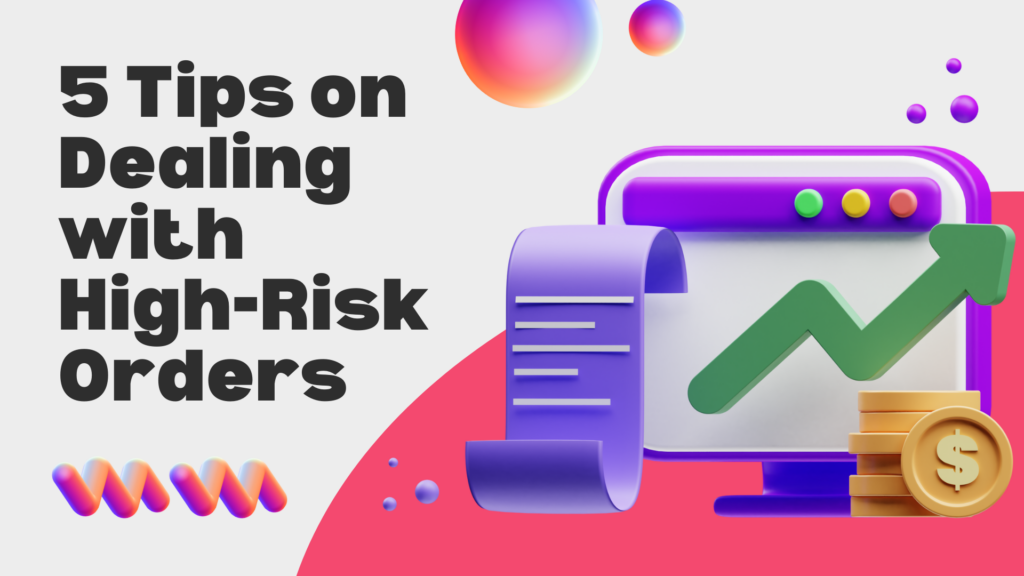The e-commerce industry is expected to reach $5.9 trillion in sales in 2023, accounting for a sizable piece of the global retail sales pie. While the sales number is growing every year, there’s also been a hike in the number of fraudulent activities, including high-risk orders.
High-risk orders are usually placed using stolen, lost, or synthetic credit cards. As such, these orders are seldom authorized by the card owner, often leading to chargebacks and other digital scams.
However, e-commerce merchants can protect themselves from fulfilling such orders and incurring a loss of revenue if they know how to recognize and deal with them.
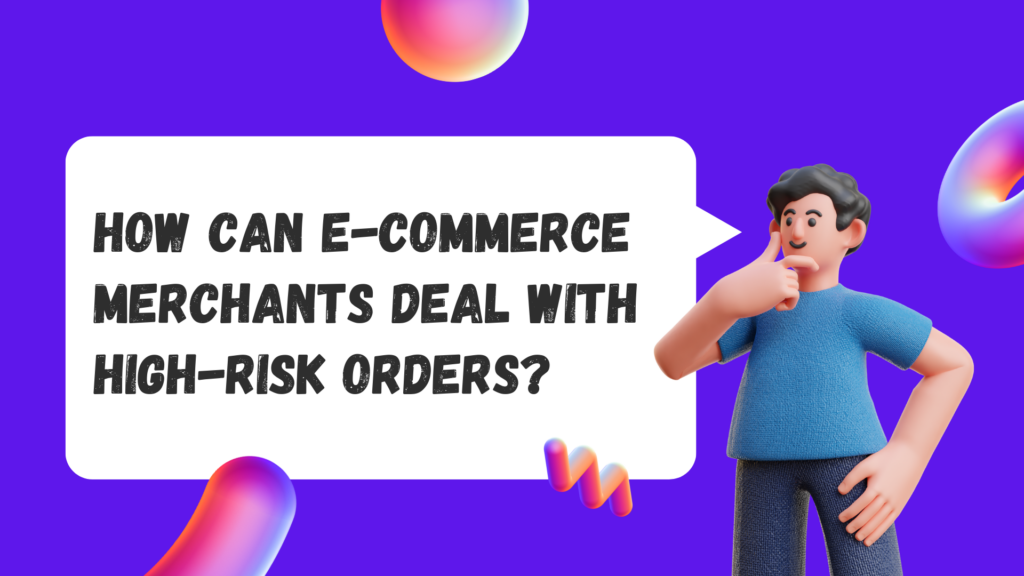
I. How Can E-commerce Merchants Deal With High-Risk Orders?
E-commerce is a highly competitive space, with millions of online stores in the US alone. However, this segment is ripe with online frauds, such as high-risk orders, making the lives of e-commerce merchants difficult. These orders are a nightmare for digital merchants and are a double-edged sword for them.
On the one hand, if they accept these orders, they might be hit with chargeback and lose money—more than twice the original transaction amount. In comparison, if they don’t accept the order, they could potentially offend a valuable customer, losing their business forever.
Moreover, high-risk orders can take the form of friendly fraud, duping innocent merchants. Friendly, or first-party, fraud is a type of fraud wherein a customer places their order, receives the delivery, and then claims that they didn’t receive the ordered item or the delivered products were damaged.
Although the customer places the order using their authorized credit card, they request the issuing bank to process a chargeback after they receive the product or avail of the services claiming that they never placed the order in the first place.
First-party fraud is fast becoming one of the most common e-commerce frauds, and almost 34% of online merchants have experienced such attacks, making it essential for e-commerce merchants to identify and steer clear of high-risk orders and their types.
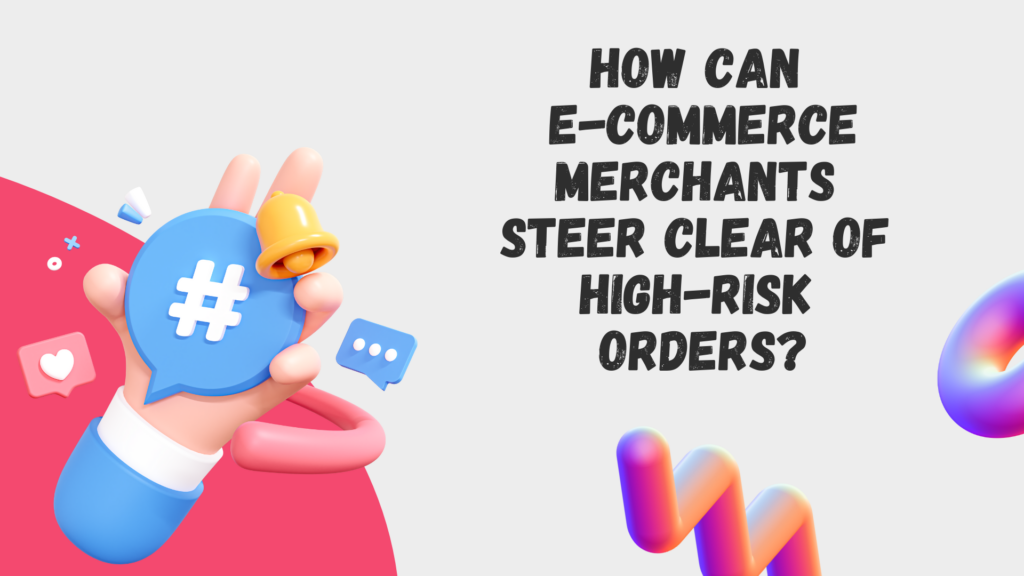
II. How Can E-commerce Merchants Steer Clear of High-Risk Orders?
When dealing with high-risk orders, online merchants are more or less at the mercy of credit card companies. However, they can tackle this issue if they know how to recognize fraudulent orders.
For instance, Shopify’s built-in fraud analysis feature helps its registered merchants recognize high-risk orders in case:
- the credit card being used has been reported as stolen by the owner,
- there’s a discrepancy in the billing and shipping address,
- the order value is high or is for a high-value product,
- there have been reports of fraud against the customer in the past, or
- the customer’s IP address is suspicious.
While Shopify merchants can review their orders and go to the Fraud analysis section to examine customer behavior based on the set indicators to avoid fulfilling high-risk orders, other online merchants must fend for themselves. With 218.8 million online buyers in the US, reviewing and identifying high-risk orders is challenging.
But it’s not all doom and gloom. E-commerce merchants can take some steps to proactively and effectively deal with high-risk orders.
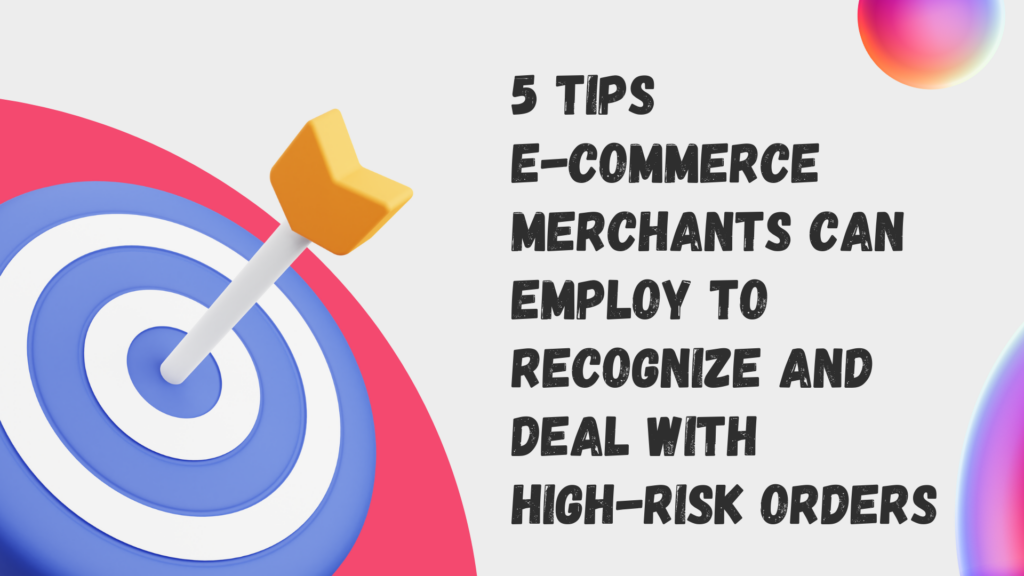
III. 5 Tips e-commerce merchants can employ to recognize and deal with high-risk orders
High-risk orders don’t just cause financial damage to merchants. They put a dent in the merchant’s reputation too. Considering this, they must take proactive measures to minimize the occurrence of such orders and protect their business and, by extension, their bottom line.
Without further ado, here are the top tips e-commerce merchants can follow to deal with high-risk orders easily:
1) Recognizing potential red flags
Determining potential red flags in your online orders is the first step to steering clear of high-risk orders. Review your orders and check the customer details to look for indicators that would put them in the risky category.
You can look for the following indicators to pinpoint a potentially fraudulent transaction:
- receiving orders from non-targeted markets,
- suspicious IP addresses,
- rush delivery requests,
- distinct billing and shipping addresses,
- orders from high-risk countries,
- unusually large orders, and
- multiple failed attempts at ordering due to security errors.
Identifying these high-risk indicators will go a long way in helping you avoid chargeback fraud. This is important because it doesn’t matter if the merchant accepts or contests the chargeback. They are the ultimate losers since:
- if they accept, they’ll have to pay the chargeback amount plus fees.
- if they don’t accept, they’ll have to send evidence to the acquirer bank, which forwards it to the issuing bank. Now, the issuing bank examines the evidence and the order details to decide in favor of the merchant or the customer.
If undecided, the issuing bank can give the merchant and customer another chance to resolve the issue by sending it to pre-arbitration. Unfortunately, the merchant only has two options: accept the chargeback or take it to arbitration.
Merchants often want to avoid the issue from escalating to the pre-arbitration or arbitration stages since they’d have to shoulder high fees in both cases. Moreover, these processes drag on for weeks and months, sapping you of the energy and effort you could’ve spent growing your e-commerce business.
-
Why should merchants be aware of chargeback fraud?
Chargeback fraud doesn’t just cost your business extra money. You’ll lose the profits on a sale and your product(s), while incurring exorbitant fees. Further, if your business faces chargebacks often, you’ll also have to bear additional penalties.
To make matters worse, you’ll be considered a high-risk merchant and charged a higher fee, given your chargeback ratio is higher than 1%. You might even be barred from accepting the company’s payment methods and lose access to a large chunk of your consumers.
This makes it necessary to take effective chargeback fraud prevention measures to protect your revenue and your business’s reputation.
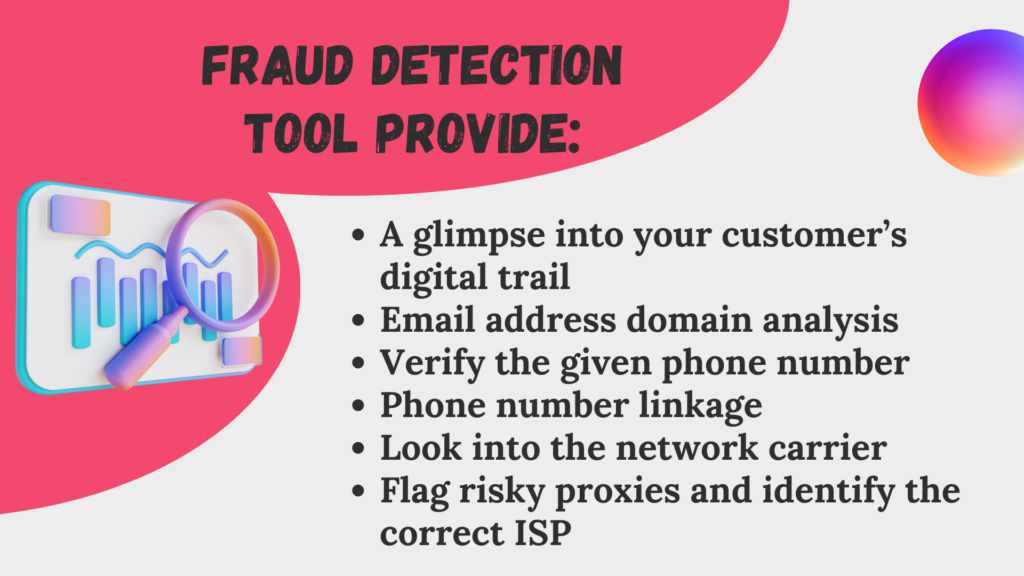
2) Use a fraud detection tool to glean essential data
To place their orders on your online store, your customers will have to fill in certain fields, such as name, email address, and phone number. Though this data is necessary to fulfill an order, it’s not enough to give you a complete picture of your customer.
This is where fraud detection tools come in. These tools can enrich your existing raw customer data by giving you some much-needed context regarding your customer from additional sources. You can use this data to understand your customers better and make informed decisions.
A robust fraud detection tool can provide you with the following data:
- A glimpse into your customer’s digital trail: check if your customer’s offered email address is tied to any other online or social media platform. You will receive their user profile picture and biography if there are any hits.
- Email address domain analysis: determine if the email address is a disposable one from a temporary domain and if the domain is risky. You can even check when the email was created and if the username and email address correlate.
-
- Verify the given phone number: find out if the number provided by the customer is valid or not.
- Phone number linkage: check if the provided phone number is tied to popular instant messaging apps. Check the account’s profile picture, biography, and last use.
- Look into the network carrier: determine the country of origin of your customer’s phone number and check if it’s a landline or mobile number.
- Flag risky proxies and identify the correct ISP: see if the customer used a proxy, VPN, or TOR network to place their order. Get ISP details to pinpoint their location and find out if their IP address was blackballed for spamming.
Taking in all this data at once would be difficult, and you might not even find any use for it immediately. However, don’t delete or toss out the data.
Store it for future purposes to verify customer information manually and decide whether you should accept your customer’s order or not. This data might even help you contest chargeback claims.
Moreover, you don’t have to go with the set high-risk rules of your fraud detection solution. You can also establish order validation processes to flag all high-risk orders based on your experience.
3) Review the flagged orders
Your chosen fraud detection software or an e-commerce’s built-in fraud detection feature might categorize several orders as high-risk. While this will allow you to weed out fraudulent orders, it won’t always be right. Moreover, rejecting too many orders on suspicion alone will harm your sales numbers and bottom line.
So make it a practice to reach out to such customers and request additional information, such as their government-issued ID card or passport, before declining their order.
For instance, if you receive an order from a high-risk location, it might seem sketchy. However, cast aside your suspicions and drop your customer an email to verify their order details and ask for identification.
If you hear back from them and the details check out, process their order. But if you don’t hear back from them within a few days, there’s a good chance that it’s a high-risk order. Whatever your suspicions, don’t cancel an order on hunch alone. Conduct your due diligence before making any final decisions.
4) Add additional security measures at the order check-out stage
Additional security measures at the check-out stage will help you eliminate fraudulent orders. You can employ the following:
- Card verification value (CVV): ask your customers to enter their card’s CVV at the time of check-out to deter fraudsters who only have access to the credit card number.
- Address verification system (AVS): this will authenticate a consumer’s billing address against that of the cardholder.
- Strong customer authentication (SCA): make it necessary for your customers to pick up a strong password that would be difficult for fraudsters to crack. Additionally, you can deploy multi-factor authentication (MFA), one-time password (OTP), and biometrics to strengthen security at the check-out stage.
While adding these protocols may increase the time your customers take to place their orders, these measures are vital and must not be overlooked. You can use data encryption, tokenization, and 3DS2 to increase security.
5) Educate your customers
Put in some effort to ensure that your customers have all the information they need at their disposal. Don’t leave any crucial information buried under tons of non-essential information or hidden in the fine print. Educating your customers about your business policies can help you avoid sticky situations like friendly fraud.
State in clear terms your return policy and give details to explain the items that would be eligible for return. Additionally, outline the return process and mention the documents, if any, needed for a successful return.
For instance, if you sell clothes, clearly mention on your store’s page what qualifies for a return—like t-shirts–and what doesn’t—like socks.
Offer as much information as possible about your products or services so that your customer isn’t underwhelmed upon the receipt of the order. Further, to avoid falling into the friendly fraud trap, mention that the refund would only be processed once the delivered item is returned in its original condition and within a specific time period.
The goal is to make it as easy as possible for your customers to return their delivery so that they can’t claim that they’d returned the product but didn’t receive the refund. This strategy will reduce the number of returns and prevent return fraud.
Moreover, make it effortless for your customers to reach you. You can set up a dedicated email or phone number for this. Don’t forget to reply to your customer’s queries as soon as you can.
Check this short video and learn how to handle high-risk orders:
IV. Bid high-risk orders goodbye
You can follow the tips mentioned to minimize fulfilling high-risk orders and getting hit by chargebacks. However, keep in mind that these tips can only help you investigate suspicious orders, but the ultimate decision is yours.
Find a balance between accepting and declining high-risk orders to avoid losing revenue on your product’s sale and offending genuine customers.

